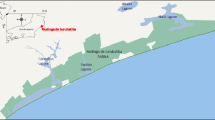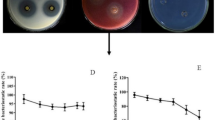Abstract
In this paper, we investigate the characterization and evaluation of the antifungal protease activity from a halotolerant strain M3-16 ofBacillus pumilus, earlier isolated from a shallow salt lake in Tunisia. Protease enzyme was highly induced by the pathogen testedin vitro (27.4 U/ml). This is the first report on high salt-tolerant protease fromB. Pumilus, since it was active at high salinity (from 5 to 30% NaCl, w/v) as well as in the absence of salinity. This enzyme showed optimal activity at 60 °C and pH 8. At 80 °C and 30 min, the enzyme retained up to 91% and it showed stability over a wide pH range (from pH 5 to 11). The enzyme was found to be monomer with an estimated molecular mass of 31 kDa. The amino acid sequence showed high similarity (94%) to ATP-dependent protease fromB. Pumilus strain ATCC 7061. Thus, our alkaline thermostable and high salt-tolerant protease induced by a phytopathogenic fungus, could be useful for application in diverse areas such as biotechnology alimentary and agronomy industries.
Similar content being viewed by others
References
Adams M.W.W., Kelly R.M. (1995). Enzymes from microorganisms in extreme environments. Chem. Eng. News., 73: 32–42.
Adinarayana K., Bapi-Raju K.V.V.S.N., Ellaiah P. (2004). Investigation on alkaline protease production withBacillus subtilis PE-11 immobilized in calcium alginate gel beads. Process Biochem., 39 (11): 1331–1339.
Banerjee V., Saani K., Azmi W., Soni R. (1999). Thermostable alkaline protease fromBacillus brevis and its characterization as a laundry additive. Proc. Biochem., 35: 213–219.
Coronado M.J., Vargas C., Mellado E., Tego G., Drainas C., Nieto J.J. (2000). Thea-amylase gene amyH of the moderate halophileHalomonas meridiana: cloning and molecular characterization. Microbiology, 146: 861–868.
Dhandapani R., Vijiayragavan R. (1994). Production of thermophilic extracellular alkaline protease byBacillus strearo-thermophilus AP-4. World J. Microbiol. Biothechnol., 10: 33–35.
Essghaier B., Fardeau M.L., Cayol J.L., Hajlaoui M.R., Boudabous A., Jijakli H., Sadfi-Zouaoui N. (2009). Biological control of grey mould in strawberry fruits by halophilic bacteria. J. Appl. Microbiol., 106: 833–846.
Ghorbel B., Sellami-Kamoun A., Nasri M. (2003). Stability studies of protease fromBacillus cereus BG1. Enzyme Microbiol. Technol., 32: 513–608.
Hiraga K., Nishikata Y., Namwong S., Tanasupawat S., Takada K., Oda K. (2005). Purification and characterization of serine proteinase from a halophilic bacterium,Filobacillus sp. RF2-5. Biosci. Biotechnol. Biochem., 69 (1): 38–44.
Kaur M., Dhillon S., Chaudhary K., Singh R. (1998). Production, purification and characterization of thermostable alkaline protease fromBacillus polymyxa. Indian J. Microbiol., 38: 63–67.
Kumar C.G. (2002). Purification and characterization of a thermostable alkaline protease from alkalophilicBacillus pumilus. Lett. Appl. Microbiol., 34 (5): 13–17.
Laemmli U.K. (1970). Cleavage on structural proteins during the assembly of the head of bacteriophage T4. Nature, 227:680–685.
Liu Y.G., Huang N. (1998). Efficient amplification of insert end sequences from bacterial artificial chromosome clones by thermal asymmetric interlaced PCR. Plant. Mol. Biol. Rep., 16: 175–181.
Nascimento W.C.A., Martins M.L.L. (2004). Production and properties of an extracellular protease from thermophilicBacillus sp. Braz. J. Microbiol., 35: 91–96.
Olayjuyigbe F.M., Ajele J.O. (2005). Production dynamics of extracellular protease fromBacillus species. Afr. J. Biotech., 4 (8): 776–779.
Patel R., Dodia M., Satya P., Singh S.P. (2005). Extracellular alkaline protease from a newly isolated haloalkaliphilicBacillus sp.: Production and optimization. Process Biochem., 40: 3569–3575.
Rao M.B., Tanksale A.M., Mohini S.G., Deshpande V.V. (1998). Molecular and biotechnological aspects of microbial proteases. Microbiol. Mol. Biol. Rev., 62: 597–635.
Rothschild L.J., Mancinelli R.L. (2001). Life in extreme environments. Nature, 409: 1092–1101.
Sadfi-Zouaoui N., Essghaier B., Hajlaoui M.R., Fardeau M.L., Cayol J.L., Ollivier B., Boudabous A. (2008). Ability of moderately halophilic bacteria to control grey mould disease on tomato fruits. J. Phytopathol., 156: 42–52.
Schisler D.A., Slinnger P.J., Behle R.W., Jackson M.A. (2004). Formulation ofBacillus spp. for biological control of plant diseases. Phytopathology, 94: 1267–1271.
Setyorini E., Takenaka S., Murakami S., Aoki K. (2006). Purification and characterization of two novel halotolerant extracellular proteases fromBacillus subtilis strain FP-133. Biosci. Biotech. Biochem., 70 (2): 433–440.
Siadiqui I.A., Haas D., Heeb S. (2005). Extracellular protease ofPseudomonas fluorescens CHAO, a biocontrol activity against the root-knot nematode meloidogyne incognita. Appl. Environ. Microbiol., 71: 5646–5649.
Smaali M.I., Gargouri M., Limam F., Fattouch S., Maugard T., Legoy M.D., Marzouki N. (2003). Production, purification and biochemical characterization of two β-glucosidases fromSclerotinia sclerotiorum. Appl. Biochem. Biotech., 11 (1): 29–40.
Sumantha A., Larroche C., Pandey A. (2006). Microbiology and industrial biotechnology of food-grade proteases: a perspective. Food. Technol. Biotechnol., 44 (2): 211–220.
Thumar J., Singh S.P. (2007). Two-step purification of a highly thermostable alkaline protease from salt-tolerant alkaliphilicStreptomyces clavuligerus strain Mit-1. J. Chromat. B., 854: 198–203.
Tian B.Y., Li N., Lian L.H., Liu J.W., Wang J.K., Zhang K.Q. (2006). Cloning, expression and deletion of the cuticle-degrading protease BLG4 from nematophagous bacteriumBrevibacillus laterosporus G4. Arch. Microbiol., 186: 297–305.
Wang S.L., Kao T.Y., Wang C.L., Yer Y.H., Cherr M.K., Cher Y.H. (2006). A solvent stable metalloprotease produced byBacillus sp. TKU004 and its application in the deproteinization of squid pen fo β-chitin preparation. Enzyme Microbiol. Technol., 39: 724–731.
Author information
Authors and Affiliations
Corresponding author
Rights and permissions
About this article
Cite this article
Essghaier, B., Bejji, M., Jijakli, H. et al. High salt-tolerant protease from a potential biocontrol agentBacillus pumilus M3-16. Ann. Microbiol. 59, 553–558 (2009). https://doi.org/10.1007/BF03175145
Received:
Accepted:
Issue Date:
DOI: https://doi.org/10.1007/BF03175145




